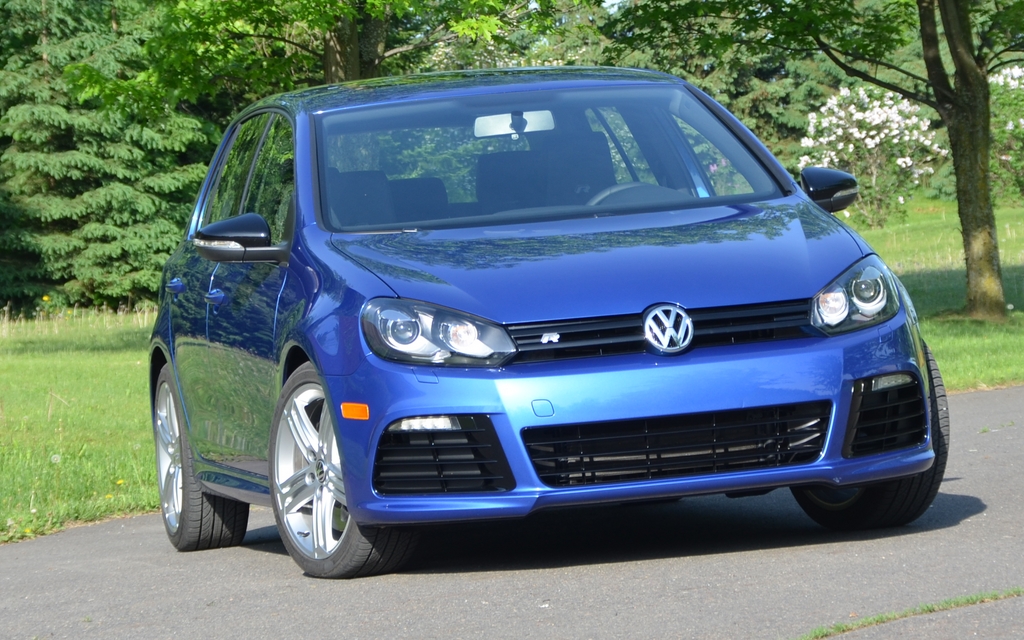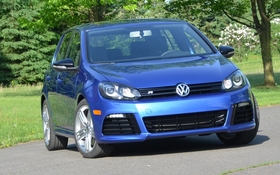Volkswagen Golf R: What every car should be

| Strong points |
|
|---|---|
| Weak points |
|
If I asked you what car represents the epitome of pleasure, what would your answer be? Ferrari, Lamborghini, Porsche, Lotus? All good choices. But there are other, much more accessible cars that bring practically immediate euphoria. There’s the Mazda MX-5, of course, the Golf GTI and for a little while now, and with only 500 units in Canada, the Golf R!
Forget the GTI. Oh sure, it’s still a lot of fun to drive but with the R, the pleasure is much more sensual. Imagine: its four-cylinder turbocharged engine with an intercooler that develops 256 horsepower and 243 lbs-ft of torque between 2,400 and 5,200 rpm, a sufficiently large range to be exploited in both low and high gear. Of course, an engine like this only takes super. And if those numbers sound familiar, it’s because it’s the same engine as the one you find in the Audi TTS!
- Also: Volkswagen may be Working on a Golf R Estate
- Also: Volkswagen Unveils a Crazy Golf R400 in Beijing
Only one transmission is offered, a six-speed manual, the same as in the GTI. And with shorter and more precise throws for the stick shift and a perfectly progressive clutch, what more could you ask for?
A friend in Haldex
When you direct 256 horses to the front wheels only, you get inevitable and unpleasant torque effect in the steering wheel followed by actuation problems. The engineers who developed the R sidestepped these issues by equipping the car with 4Motion all-wheel drive. And you can believe that whether it’s in turns, accelerations or on roads in poor condition, the actuation is extraordinary. As my colleague and friend Marc Lachapelle said during his test drive of the R in Lapland last winter, its multi-disc central differential always transmits 4% of the torque to the rear wheels. This proportion can climb to nearly 100% depending on conditions, while it was limited to 50% on the previous versions of the Haldex AWD.
The suspension has been reinforced and lowered by 25 mm, the brake discs are bigger, the steering is exquisitely precise and offers very interesting tactile feedback. But none of that means anything if the chassis comes from a 1983 Reliant K. Luckily, this is not the case. Volkswagen has long been recognized for building ultra-rigid platforms and it continues to hone the craft.
Classic German simplicity
Physically, the R doesn’t stand out as much as I would have liked. Those unfamiliar with the subtleties of the automobile will notice its increased presence, like with our test car, which stood out with its Rising Blue paint job. But those in the know will also notice the front bumper with larger air intakes, the dual central exhaust, black brake calipers with a white “R”, and the Pirelli P Zero Nero 225/40R18 tires. In the passenger compartment, the R sets itself apart from the working-class Golfs with multiple “R” badges and different leather seats, gauges and shifter.
Offered in Canada only as a five-door (Europeans and Americans also have access to a three-door), the R is as versatile as the other Golfs. The trunk is very large and the passenger compartment is at once spacious and comfortable despite the presence of an awful lot of black. The visibility is excellent all around and the dashboard, while its design is far from flashy, is very user-friendly. And the Dynaudio sound system asks only that you lend it your ears.
As soon as you turn the ignition key (or more accurately, push its Start/Stop button), the 2.0-litre engine has a pleasant sound. Sure, it’s not the 1969 Mustang’s good old 390, but for a four-cylinder, it’s excellent. Once the accelerator is pushed even slightly, power is delivered immediately and accelerations are completely linear. However, it’s a tad difficult to accelerate from a standing start without a noticeable loss of power because of the all-wheel drive and the exceptional actuation that it provides. Fortunately, even after a few trials, the clutch doesn’t demonstrate any weakness. Once the driver learns to regulate the clutch and accelerator properly, it has a brilliant 0-100 km/hr time of less than six seconds. And pick-up is equally brilliant: 5.9 seconds is all it takes to go from 80 to 120 km/hr, and that’s in fourth gear. In third, we’re talking 4.3 seconds. At the end of our week-long test drive, our R guzzled 11.0 L/100 km, which is quite a bit more than a regular Golf. But we won’t let two or three litres per 100 km spoil our fun!
Surprisingly, the suspension seems softer than with the GTI, but we’d have to test drive them both the same day on the same road for a proper comparison. In turns, the R is simply fantastic. There’s no roll and no understeer, unless, of course, you try to defy the laws of physics. The brakes are very powerful and even after three consecutive emergency stops, they don’t show any signs of weakness. Frankly, the 130 extra kilos compared to the GTI aren’t noticeable in the least.
Fun has no price
Are there little problems? Of course, there are a few. At 120 km/hr, I found the sound of the exhaust annoying. Because the central console is very large, I was always obliged to press my knee against it. But these are minor issue. Much less trifling, however, is the $40,000 price tag, some $9,300 more than a GTI. That’s starting to be expensive for a Golf. But since the R will definitely become a collector’s car and, before we find it at classic car shows, its resale value promises to be very high, why deny yourself the pleasure?











